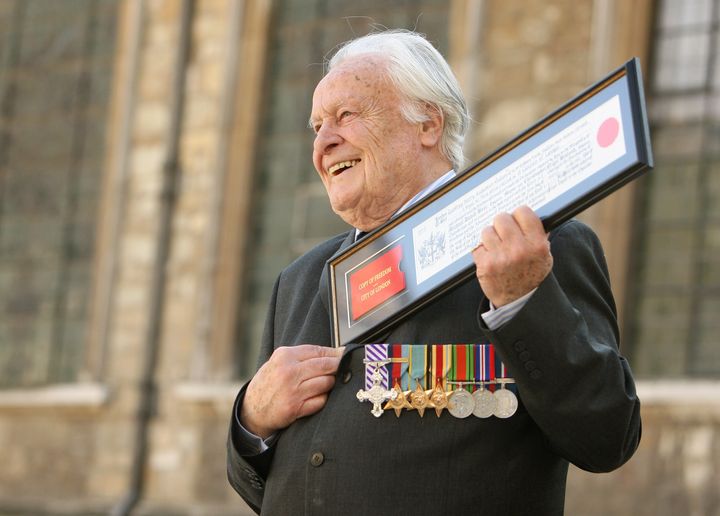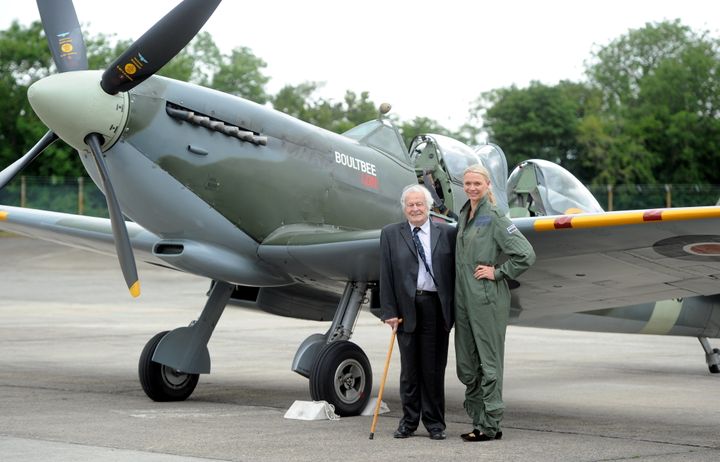
The youngest Spitfire pilot to fly in the Battle of Britain has died.
Geoffrey Wellum, who was just 18 when he joined the RAF in August 1939, died at his home in Cornwall on Wednesday evening, the Battle of Britain Memorial Trust said.
One of the “Few”, the decorated veteran airman was approaching his 97th birthday.

The former squadron leader served on the front line with 92 Squadron and some of his first combat missions included the “dogfights” above London and the Home Counties for which the Battle of Britain became known.
He went on to be awarded the Distinguished Flying Cross and was promoted to Flight Commander with 65 Squadron and later led eight Spitfires from HMS Furious to relieve Malta.
The Battle of Britain Memorial Trust’s secretary Patrick Tootal said members of the charity’s staff and volunteers had been “much saddened by the news”, adding: “Only this week Sqn Ldr Wellum had been talking enthusiastically about attending the Memorial Service at Westminster Abbey on 16 September.”
Speaking in 2013, Mr Wellum told how he was sent out to fly while still in his teens.
“Somebody said: ‘Here’s a Spitfire – fly it, and if you break it there will be bloody hell to pay’,” he said.
“I ended with 146 hours of flying time.
“Looking at my life now, I had peaked at about 21 or 22.
“It was just lovely blokes, all together in Fighter Squadron.”
Wellum stayed on in the RAF until 1960 and went on to write a best-seller about his experiences in the war – his 2002 memoir First Light.
The book was later adapted into a film for BBC television.
Wellum’s death follows that of Wing Commander Tom ‘Ginger’ Neil last Wednesday.
Geoffrey Wellum: Obituary

Geoffrey Wellum once joked that his life had “peaked” at the age of 21.
In 1939, when he was just 18 years old, he had joined the RAF on a short-service mission.
Within months he found himself thrust into combat – and became involved in one of the most decisive campaigns of the Second World War.
The youngest Spitfire pilot in the prestigious 92 Squadron, he flew in terrifying “dogfights” above London and the Home Counties, defending Britain from the encroaching Nazi threat in the summer of 1940.
Hundreds of lives were lost in the Battle of Britain – a fact that must have seemed incomprehensible to someone of such tender years.
But Wellum, born in Essex in 1921, found a sense of peace in flying, and knew that his and his colleague’s efforts would have a huge impact on the outcome of his country’s fate in the war.
Speaking in 2013 of losing comrades, he said: “You just had to accept it, get on with living and remember absent friends.
“Once you let your imagination run away you might just as well fly into the ground and kill yourself.
“Sometimes you got a great of sense of peace when you were flying which you couldn’t define – peace from an unknown presence.”
The Luftwaffe lost almost 2,000 aircraft in the battle which raged throughout the summer, while the RAF lost more than 900.
Wellum flew between 50 and 60 flights over the period, and once said the most terrifying aspect of the conflict was being engaged in a dogfight.
He said in an interview in 2010: “If you were in one-on-one combat and you could see the man behind you trying to shoot you down, you knew the meaning of the word fear.
“In fact I found myself on one occasion fairly calmly saying to myself, ‘I’m going to die’.”
Recounting his first large battle, he recalled: “There was only 10 of us and pretty soon that got down to just two.
“The controller vectored us to 150-plus enemy aircraft that looked like a whole lot of gnats on a sunny evening in the distance.
“I remember being a bit daunted by this and I thought, where do you start on this lot, so I did the obvious thing and went straight in underneath them, had a quick fire and got out of it.
“Mainly you didn’t have time to be frightened – you were busy flying for your life, really.”
Survivors of the Battle of Britain went on to be dubbed “The Few”, in reference to Churchill’s celebrated line: “Never in the field of human conflict was so much owed by so many to so few.”
He later became a test pilot at Gloster Aircraft, testing the Hawker Typhoon, and ended the war as a gunnery instructor.
Wellum left the Royal Air Force in 1961 and went on to work in a firm of commodity brokers in the City.
He later retired to Cornwall, where he died on Wednesday evening at the age of 96.
Reflecting on his life in 2013, Wellum said: “Looking at my life now, I had peaked at about 21 or 22.
“It was just lovely blokes, all together in Fighter Squadron.”